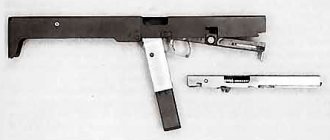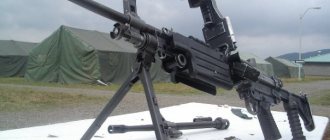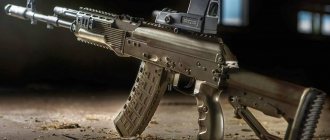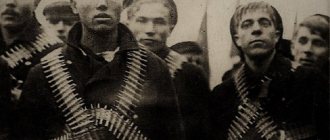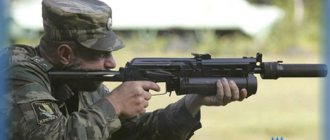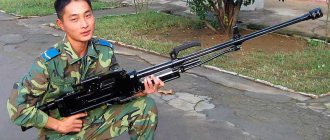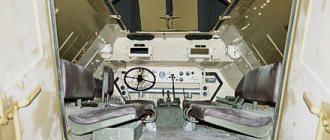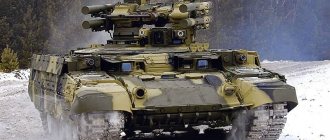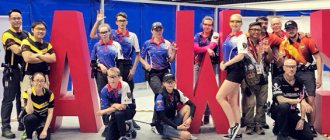Equipment and weapons No. 6 - 2002 Machine guns. Modern light machine guns.
Name:
Equipment and weapons No. 6 - 2002 Special issue - Machine guns.
Modern light machine guns. Author:
S. Fedoseev
Publisher:
ROO "Techiform"
Year:
2002
Pages:
52
SPECIAL EDITION
For about a hundred years, machine guns have been an integral part of the armament system of the ground forces, the most widespread means of fire support for units. During this period, they gained such strong positions that not a single type of battle can be imagined without them. Neither the widespread introduction of light automatic weapons, nor mortars, nor automatic grenade launchers and small-caliber guns, nor the increase in the security of troops could shake these positions - only the principles of using machine guns, their interaction with other weapons and, accordingly, the requirements for them changed. Currently, the armed forces of different countries use a wide range of machine gun weapons.
The limited scope of the special issue forces us to limit the consideration of these weapons to tactical and time frames. Therefore, about fifty models of light, single and heavy machine guns used in the infantry and created - or significantly modernized - after World War II were selected for description. Of the “veterans with pre-war experience,” only the British Bran, the Soviet DShK and the American M2NV Browning, which are still used today, will be mentioned. Models of tank machine guns will be mentioned in passing, and aviation (helicopter) ones, like many experimental models, will not be considered.
In this issue we will only talk about light machine guns.
Austria Light machine guns of the AUG "Steyr" family
Belgium Light machine gun FN 50-41 (FALO) Light machine gun "Mini" Great
Britain
Light machine gun "Bran" L4 Light machine gun L86A1
Israel
Assault rifle - light machine gun "Galil" ARM
India
Light machine gun INSAS
Italy
Light machine gun AS70/90 "Beretta"
People's Republic of China
Type 58 light machine gun Type 74 light machine gun Type 81 light machine gun
Mexico
RM2 "Mendoza" light
Union of Soviet Socialist Republics / Russia
RPD light machine gun RP-46 company machine gun RPK light machine gun RPK-74 light machine gun Light machine gun RPK-74M
Singapore
Light machine gun "Ultimax"-100
United States of America
Light machine gun M249 SAW
Finland
Light machine gun M62 "Valmet" Light machine gun M78 "Valmet"
Federal Republic of Germany
Single/light machine gun "Heckler und Koch" NK21 (NK23) Manual machine gun "Heckler und Koch" NK11 (NK13) Light machine gun MG36
Czechoslovakia
Light machine gun of the LADA family Light machine gun Vz.52
South Korea
Light machine gun KZ "Daewoo" Tactical and technical characteristics of machine guns Literature materials are presented in the form of a brief description or content and are intended exclusively for forming an idea of their essence. On the liters portal you can get detailed information about various literature, read and listen online, as well as purchase and download it.
PTC structure and operating principle
The design of the Kalashnikov tank machine gun is based on a gas engine - a mechanism that is found on the AK-74, the RPK and even the modified Saiga hunting carbine. The operating principle of the system is as follows:
- First, the shooter pulls the trigger, thereby firing a shot. The firing pin strikes the primer of the cartridge, causing the gunpowder to ignite and generate a large amount of energy.
- Most of the powder gases act on the bullet, pushing it out of the barrel. However, a small amount (about 20%) ends up in a special branch of the chamber called the gas chamber.
- In the gas chamber, carbon dioxide presses on the piston, thereby triggering the reloading mechanism: the bolt opens, the spent cartridge case is released under the action of the extractor (cartridge ejector), and the trigger returns to the firing position.
- At the moment the bolt frame is closed, new ammunition is supplied from the magazine to the chamber, since all projectiles are under the action of a compressed spring. After this, the bolt closes three lugs and the weapon again becomes ready for battle.
The entire reloading process takes a matter of seconds, so it is not surprising that the machine gun has such a high rate of fire. However, due to the fact that the gas engine is designed for a certain energy level, the shooter does not have the opportunity to use cartridges with an increased or decreased powder load (the automatic system may break or not work).
In addition to the gas engine, the Kalashnikov tank machine gun consists of several other main parts and mechanisms. Here is their brief description, as well as the main features that distinguish the PKT from other rifle units:
- The barrel is the part of the weapon through which the bullet travels after the gunpowder is ignited. It is not surprising that the barrel channel has enormous strength (can withstand loads of up to 5000 J) - all due to the use of high-quality weapon steel that has undergone a cold forging procedure. At the end of the barrel there is usually a flash suppressor or muzzle brake-compensator designed to reduce the recoil of the weapon.
- The chamber is the place where the ammunition intended to be fired is located. Like the barrel channel, the part is made of heavy-duty material that is hardened at low temperatures. Also inside the chamber has a chrome coating, which provides increased metal strength and long service life of the weapon. The chamber is where the gunpowder is ignited, so this part must be the strongest.
- USM is a firing mechanism that ensures cocking of the firing pin, as well as its release. The system consists of several main and return springs, couplings, pins, sears and a trigger petal. To prevent an accidental shot, the trigger is equipped with a safety lock that blocks the trigger. Removing the weapon from the safety lever is done using a special flag lever.
- Stock - consists of a plastic or wooden butt, forearm and metal receiver. This detail affects the ergonomics of the weapon, as well as its usability when shooting without the use of a bipod or machine. Depending on the modification and configuration, the machine gun can be equipped with a rubber butt-shock absorber mounted on the back of the butt (used to absorb recoil).
In addition, the weapon is also equipped with a cartridge belt, sighting device, bipod or machine and other less important elements. However, the electric trigger button deserves special attention, which allows the shooter not to hold the trigger blade to fire. The mechanism consists of several electric magnets and a small power source.
The history of the creation of the PTK machine gun
The history of the creation of the Kalashnikov tank machine gun dates back to 1961. At that time, the USSR government ordered the development of powerful automatic weapons for military equipment, which would replace the outdated MG-34 and MG-42 machine guns (used since the Second World War). The idea of creating a “single machine gun” for tanks and armored personnel carriers was picked up by the legendary designer Mikhail Kalashnikov. Together with a team of experienced engineers, he began developing a new automatic weapon chambered for 7.62x54R, using a gas engine for reloading.
In 1969, the first modification of the PKT appeared, equipped with a Stepanov machine. It is this version that is now actively used by the Russian army, since the weight of the entire structure is only 7.5 kg, and not 9 kg, as it was in the original. Subsequently, M. Kalashnikov, in tandem with Izhevsk engineers, developed several more improved versions of the PTK - PKM, PKMS, PKTM and PKMB. The newest development at the moment is the PKM weapon (modified Kalashnikov machine gun) with a machine designed by Nikitin.
During the development of the PTK and its modifications, IZHMASH engineers were guided by the principle of creating a “single machine gun”, the design of which should make it possible to easily transform the weapon from a tank turret into an infantry version or a model with an installed machine gun (for the defense of a certain position). Thanks to this feature, the Kalashnikov tank machine gun gained popularity not only in Russia, but also in other countries, so it is not surprising that in many African and Asian countries this model is still in service.
Ammunition for PTK (Kalashnikov machine gun)
For firing, the PTK uses 7.62x54R caliber cartridges - a fairly old unitary cartridge that was used back in the days of the Russian Empire. A striking example of a weapon that fired this ammunition is the legendary Russian three-line rifle - the Mosin rifle. A distinctive feature of the cartridge is the presence of a protruding rim, which was used to remove the spent cartridge case using a special hand-held device. The technical characteristics of the projectile are as follows:
| Characteristic | Parameter |
| Case length | 7.62 mm |
| Sleeve width | 53.72 mm |
| Powder charge mass | 3.25 grams |
| Bullet weight | 13.75 grams |
| Initial bullet speed | 860 m/s |
| Shot energy | 3840 J |
Of course, these parameters will change depending on what weapon is being fired from. However, if you compare the performance characteristics of the weapon and the characteristics of the cartridge, the difference is small. Well, the reason for using such old ammunition in a machine gun is obvious: the low cost of the projectile (from 23 rubles per piece), as well as the availability of a large number of cartridges in military warehouses.
Also, the performance characteristics of the ammunition will change depending on which bullet is installed on the cartridge - a regular semi-jacket, armor-piercing or tracer. The first option has average weight indicators, and the tip is not colored in any way. The armor-piercing bullet has an increased mass and is painted black. The tracer has minimal weight and a special green coating.
Disassembling the machine gun
Despite the fact that the design of the Kalashnikov machine gun at first glance looks quite complex, incomplete disassembly of the machine gun will not cause problems even for an inexperienced military man. Here is a detailed algorithm of actions that you need to follow to disassemble the model:
- We place the machine gun on a table or mat so that it faces the muzzle forward.
- We check the chamber for the presence of a cartridge (pull back the bolt and see if there is a cartridge case there).
- We take out all the necessary accessories from the spare parts kit.
- We separate the recoil spring rod from the main part of the bolt frame.
- Separate the bolt frame together with the bolt (movement down and back).
- Separate the bolt from the bolt frame.
- We take out the firing pin from the bolt.
- We remove the electric trigger from the machine gun (the latch is recessed with a drift).
- We remove the barrel.
That's all - partial disassembly of the machine gun is completed. Further disassembly (complete) is carried out only if one of the mechanisms breaks down and requires special tools. Assembly is carried out strictly in reverse order.
When disassembling a machine gun, do not place it on the ring ledge under any circumstances - this may result in breakage or deformation of the fragile part.
Video with disassembly of PCM (modification of PKT).
